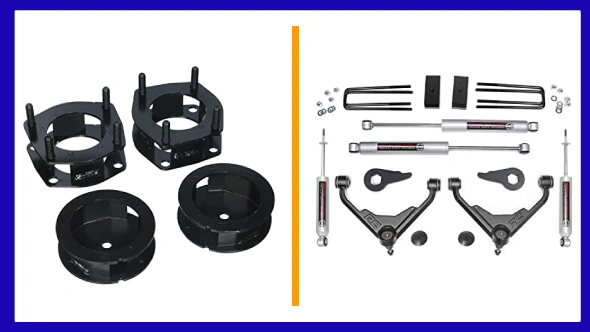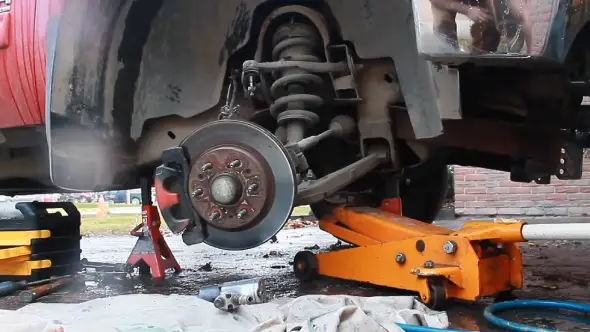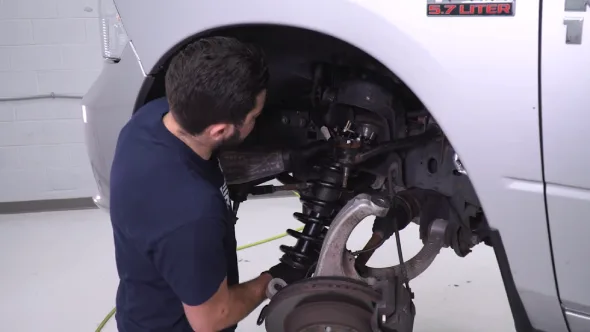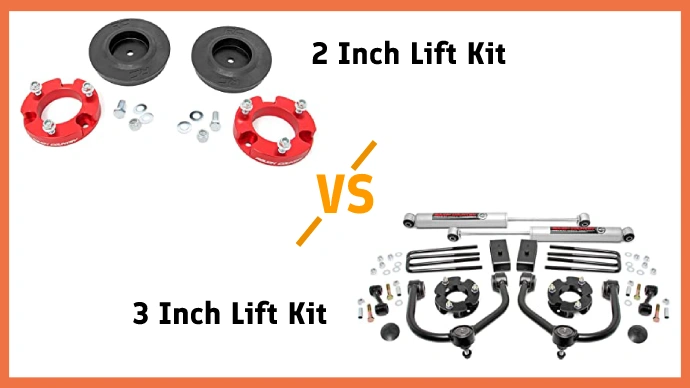Last Updated on May 7, 2023
If you want to tackle some tougher terrain, there’s nothing quite like lifting your vehicle and increasing the ground clearance.
But when it comes down to picking between a 2-inch or 3-inch lift kit, what do you choose? It all boils down to understanding the differences between each.
While both provide increased ride height and improved off-road capability, there are some notable differences between the two. The most obvious difference is the amount of lift they provide, with a 3-inch lift kit providing more ground clearance than a 2-inch lift kit.
3-inch lift kits come with a heftier price tag than their more compact 2-inch alternatives, so you’ll have to dig deeper into your pocket if opting for the bigger upgrade.
A 3″ lift kit can open up the opportunity for bigger, more rugged tires. But with a 2-inch lift kit, you may not have enough clearance for larger tires. Let’s cut right through all the details, so you get exactly what you want for your vehicle.
2 Inch Vs 3 Inch Lift Kit: Major Differences

Whenever you’re looking to take your ride’s style up a notch, consider the exciting differences between 2 vs. 3-inch lift kits. With just an extra inch of height comes improved off-roading capabilities, plus increased protection from obstacles.
Get ready for more fun on your next adventure. Check out these key differences between them and see what works best for your ride.
1. Height
A 2-inch lift kit raises the vehicle’s height by 2 inches, while a 3-inch lift kit raises it by 3 inches. When deciding between these options, consider how much you want your vehicle to be lifted.
If you’re looking to make a dramatic difference, then the 3-inch lift might be a better choice. But if you want something more subtle and don’t need such an extreme height increase, then the 2-inch option could do just fine.
Keep in mind that even though a 3-inch lift is higher than a 2-inch lift, it can also affect the angle of approach and departure when climbing or descending hills or traversing uneven surfaces.
2. Center of Gravity
Compared to a 2-inch kit, a 3-inch lift kit elevates the vehicle’s center of gravity more, which can affect its handling and stability. This means that when out on the roads or trails with a higher center of gravity, your driving experience may not be as smooth as it would be with a lower center of gravity.
On top of that, if you plan on taking your vehicle off-roading at all, then you’ll want to consider how much additional stress an increased center of gravity will put on its components.
3. Installation Difficulty
Installing a 3-inch kit is generally more difficult than installing a 2-inch suspension lift kit due to the need for additional modifications. These include extended brake lines, sway bar relocation brackets, and differential drop kits.
Also, many components of a 3-inch lift must be individually custom fit for your specific vehicle type to ensure proper installation and performance.
As such, these types of lifts often require professional installation or at least significantly more labor than their 2-inch counterparts.
4. Cost
A 3-inch lift kit tends to be usually more expensive relative to a 2-inch kit due to the additional components required for larger lifts, such as extended brake lines, adjustable control arms, etc.
In addition to these components, other costs are associated with installing bigger lifts. For instance, labor costs could potentially add up quickly depending on the job’s complexity. So make sure you factor this into any budget considerations before purchasing.
5. Suspension System
Adding a 3-inch kit to the vehicle typically requires a more robust suspension system to accommodate the extra height and weight. This likely means upgrading components such as shocks, struts, and springs if you want to ensure optimum performance and safety.
By comparison, a 2-inch lift typically doesn’t demand as many changes or upgrades, allowing you to enjoy the benefits of a little extra height with minimal disruption.
6. Fuel Economy
When thinking about fuel economy with either side of a lift kit, know that a 3-inch lift can decrease fuel economy more than a 2-inch kit. This is due to increased weight and drag caused by the higher suspension and larger tires.
The difference won’t be noticeable if you only drive short distances or stay on paved roads. But those who frequently travel long distances or go off-road should consider this before choosing the right kit.
7. Ride Quality
When considering 2-inch verses 3-inch lift kits, the ride quality is one of the most notable differences. A 2-inch lift kit generally provides a smoother and more comfortable ride than a 3-inch lift kit.
This is because it raises the vehicle at a slightly lower angle, which keeps the vehicle’s center of gravity lower and reduces body roll. It also puts less strain on the suspension components and allows for better shock absorption on rough terrain.
Conversely, a 3-inch lift can affect the vehicle’s ride quality significantly due to its higher angle. When you drive over rough terrain, it makes the ride bumpier because it raises the center of gravity.
It also puts more strain on the steering and suspension components, potentially leading to premature wear and tear.
8. Handling and Steering
Another major difference between 2-inch and 3-inch lifts is their effects on handling and steering. A 3-inch lift has a greater impact than a 2-inch lift due to its higher center of gravity.
This can cause more body roll, sway, and instability when driving at high speeds or taking sharp turns. Also, it can put increased strain on steering components such as tie rods or ball joints which can lead to premature wear or even failure in some cases.
In comparison, a 2-inch lift will have less of an effect on handling and steering due to its lower center of gravity.
The reduced body roll helps keep the vehicle stable in fast turns or during hard braking maneuvers while also putting less strain on steering components like tie rods and ball joints. It also helps to reduce fatigue from long drives by providing a smoother ride overall.
9. Load Capacity
A 3-inch lift kit may increase your vehicle’s load capacity more in comparison to a 2-inch lift kit. This is due to its taller suspension components supporting heavier loads without bottoming out or sagging too much.
You should consider this when determining your vehicle’s payload capacity rating,, as exceeding this rating could damage or break critical components like springs and shocks.
10. Off-Road Performance
Adding a 3-inch lift kit to your off-road vehicle will make it significantly more capable off-road, as it offers greater ground clearance and more options for tire selection.
A 3-inch lift allows you to use larger tires for better grip and traction in difficult terrain types. It also improves approach and departure angles when navigating steep surfaces and increases articulation for increased stability.
These features are simply not achievable using a 2-inch kit, making a 3-inch lift the superior offering when taking your vehicle off-road.
11. Installation Time
Installation time is usually longer for a 3-inch lift than for a 2-inch lift. This is because more components are needed, and greater precision is required for proper alignment and safety.
A professional installer would likely take longer to install a 3-inch lift than a 2-inch one since they’d need to make more modifications and pay attention to the details of the job. If you’re installing it yourself, you should plan for extra time due to the complexity of the project.
Do I Need New Shocks When Installing a 3-Inch Lift Kit?

When you install 3-inch lift kits on your vehicle, it is generally necessary to install new shocks. The original shocks may not be able to extend far enough to properly support the increased distance between the top and bottom mounting points of the shock.
If this is the case, you must replace them with specially designed shocks for a 3-inch lift. These shocks have extended travel capabilities, allowing them to absorb more energy from bumps and dips in the road, ensuring a smoother ride.
Also, they allow for better weight distribution across all four wheels when driving off-road or on uneven terrain.
What Size Tires Can I Fit Using a 2-Inch Lift Kit?
With a 2-inch suspension lift, you can fit 33-inch tall tires on your vehicle. A suspension lift will raise the body of your car or truck while leaving the frame at its original height.
This makes it easier to install larger tires as they have more room to fit without any changes to the frame itself. The 33-inch tall tire size is a popular option for lifted vehicles and provides an improved look and performance on off-road trails.
Do I Need to Modify the Drivetrain for Installing 2 or 3 Inch Lift Kits?

Most lift kits are designed to be compatible with existing drivetrain parts, so you may not have to worry about making modifications.
But, it’s always best practice to double-check with the lift kit manufacturer before installation just in case any special modifications are required.
Depending on the type of lift kit and vehicle, certain components, such as driveshafts or axles, might need to be replaced for everything to fit properly.
Without these replacements, the vehicle won’t perform safely and reliably. Therefore, if you want your vehicle to run at its optimal performance level, it’s essential that you do research and make sure any necessary modifications are done correctly.
It’s also important to note that not all lift kits are universal. Some may not fit certain vehicles unless specific tweaks and adjustments are made. That’s why researching ahead of time can save you from running into costly repair issues down the line.
Go ‘Off-Road’ or Go Home: Get the Perfect Lift Kit for Your Vehicle
Ultimately, when selecting the right size lift kit for your vehicle, it is imperative to consider all factors of your goal.
A 3-inch lift kit provides more ground clearance and enhanced off-roading capabilities than its 2-inch counterpart, though it is significantly costlier and often requires additional changes to install appropriately.
While more economical options are available, the larger lift kits may be worth the expense if you plan to do a substantial amount of off-roading or need higher ground clearance for any reason.
Accordingly, researching heavily beforehand is key in deciding on the perfect lift kit for you and your vehicle.
